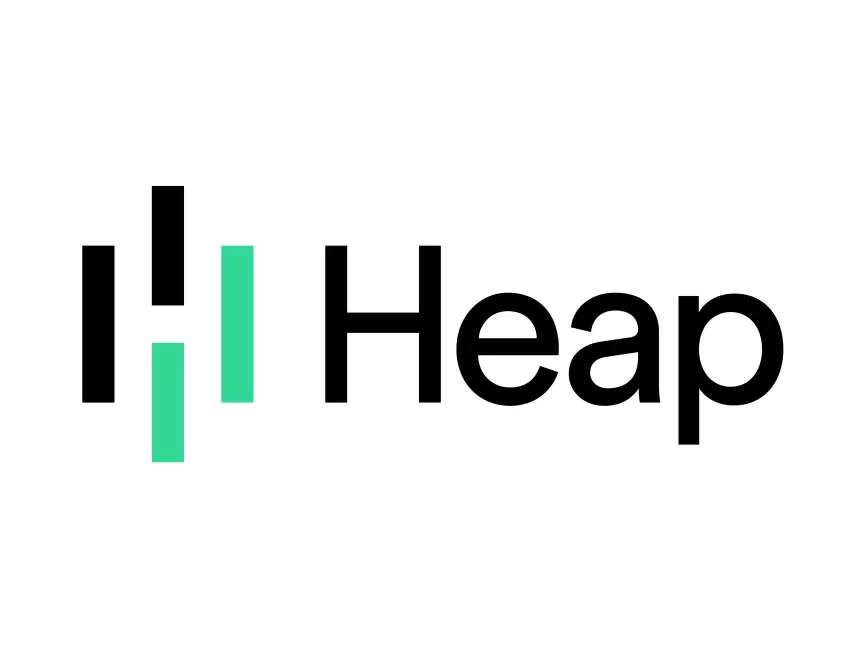Choosing the right marketing analytics tool is like picking your best ally in the ever-evolving battlefield of the digital world. It’s not just about who has the flashiest weapons or the fanciest armor; it’s about finding the one who understands your unique battles and fights by your side, tirelessly. Today, we’re diving deep into the realms of Mixpanel and Heap, two of the most acclaimed warriors in the analytics arena. Both are mighty, but only one can be the best companion for your journey. Let’s start with a critical area of comparison: user interface and ease of use.
| Mixpanel | Heap |
|---|---|
 |  |
| G2 Score – 4.6 out of 5 stars | G2 Score – 4.4 out of 5 stars |
| TrustRadius Score – 8.4 out of 10 | TrustRadius Score – 8.2 out of 10 |
User Interface and Ease of Use
Picture this: You’ve just signed up for a new analytics tool. You’re excited, ready to dive in and unearth the secrets hidden in your data. But as soon as you log in, you’re met with a dashboard so complex, it feels like you need a PhD in Data Science to make sense of it. Frustrating, right? This is where the distinction between Mixpanel and Heap becomes crystal clear.
The Mixpanel Experience
Mixpanel prides itself on a user interface that is both sleek and functional. The dashboard greets you with a clean, minimalist design that emphasizes clarity over clutter. Navigation is intuitive, with most features just a few clicks away. This ease of access is not just skin deep; it extends to the very heart of Mixpanel’s operation.
Creating custom events and funnels in Mixpanel is straightforward. You can track specific user actions with just a few clicks, and setting up funnels to understand user journeys is similarly user-friendly. Mixpanel also offers a range of visualization options, from simple line graphs to more complex data plots, making it easier for you to digest the information at a glance.
However, it’s not all sunshine and rainbows. New users might find the initial setup a bit challenging, especially when it comes to integrating Mixpanel with their existing platforms. While the documentation is comprehensive, the learning curve can be steep for those not technically inclined.
The Heap Approach
Heap takes a slightly different approach. It aims to remove the barriers of manual event tracking by automatically capturing all user interactions from the get-go. This “capture everything” philosophy means you don’t have to decide in advance what to track, which can be a godsend for non-technical users or those who are unsure about what metrics will be most valuable to them.
This automatic data capture makes Heap incredibly easy to start with. There’s no need to spend hours setting up events or worrying about missing out on important user actions because you didn’t think to track them. However, this approach has its downsides. The wealth of data Heap collects can be overwhelming, and finding the specific insights you need might feel like looking for a needle in a haystack.
Heap’s interface is designed to manage this flood of information. It’s clean and relatively intuitive, with a strong focus on filtering and segmentation to help you sift through the data. Yet, the sheer volume of automatically collected data means that learning how to effectively use these filters and segments is crucial, adding a layer of complexity to the user experience.
The Verdict on User Interface and Ease of Use
In the showdown between Mixpanel and Heap regarding user interface and ease of use, it’s a tale of two philosophies. Mixpanel offers a more traditional, hands-on approach, granting you the power to meticulously craft the data you collect but requiring a bit more effort to set up and master. Heap, on the other hand, champions ease and automation, potentially saving you time upfront but challenging you to master its depths to find meaningful insights.
The choice between these tools depends on your specific needs and preferences. Do you value complete control and precision, or do you prefer comprehensive capture and simplicity? Your answer to this question will guide you to the right tool for your journey.
Data Analysis and Reporting Capabilities
Once you’ve navigated the user interface and started collecting data, the next crucial battleground is how effectively you can analyze and report on that data. After all, what good is data if you can’t understand it and make informed decisions based on it? Let’s compare Mixpanel and Heap in terms of their data analysis and reporting prowess.
Diving Deep with Mixpanel
Mixpanel excels in providing advanced analytical tools that allow you to dig deep into your data. Its strength lies in the ability to perform complex analyses without requiring you to be a data scientist. One of Mixpanel’s standout features is its segmentation capabilities. You can dissect your data based on various user attributes and behaviors, enabling you to understand not just what is happening on your site or app, but also who it’s happening to and why.
Furthermore, Mixpanel’s funnel analysis tool is particularly powerful. It allows you to identify where users drop off in a particular journey or process, helping you pinpoint areas for improvement. Whether you’re optimizing your onboarding process or trying to increase checkout conversions, these insights can be invaluable.
Mixpanel also offers robust A/B testing features, making it easier to test changes and understand their impact on user behavior. This can be a game-changer for making data-driven decisions to enhance user experience and engagement.
However, Mixpanel’s advanced features can sometimes be a double-edged sword. While they offer deep insights, crafting these complex reports can be daunting for beginners. Additionally, to get the most out of Mixpanel, you’ll likely need to spend some time learning its ins and outs, which could be a significant investment for smaller teams or businesses.
The Automatic Insights of Heap
Heap approaches data analysis with a philosophy that aligns with its data collection method: make everything as automatic and straightforward as possible. This approach is evident in its analysis features, where the tool uses the data it automatically collects to generate insights without much manual setup.
One of the most appealing aspects of Heap is its ability to quickly give you insights into user behavior without requiring extensive configuration. Thanks to its automatic event tracking, you can start analyzing user interactions from day one, exploring trends, and identifying patterns without the need to define events or properties upfront.
Heap’s visualizations are designed to be accessible, aiming to make data analysis less intimidating. Its interface allows users to construct queries and generate reports with just a few clicks, significantly lowering the barrier to entry for effective data analysis.
However, the trade-off for this ease of use is that Heap might not offer the same level of depth in analysis that Mixpanel does. While it’s excellent for getting a broad overview and identifying general trends, if you need to perform highly specific or complex analyses, Heap’s simplicity might feel limiting.
Analysis and Reporting: A Matter of Depth vs. Accessibility
When comparing Mixpanel and Heap in the realm of data analysis and reporting, the choice again boils down to what you value more: the depth and precision of Mixpanel or the accessibility and ease of Heap. Mixpanel offers more powerful tools for deep data dives and precise experimentation, suited for teams ready to invest time in learning its features. On the other hand, Heap provides a more user-friendly approach, ideal for those who prefer simplicity and immediate insights, even if it means sacrificing some depth.
Integration Capabilities and Ecosystem
In today’s digital landscape, your marketing analytics tool doesn’t operate in isolation. It’s a part of a broader ecosystem of applications and services that work together to drive your business forward. The ability to integrate seamlessly with other tools can significantly enhance the value of your analytics platform. Let’s see how Mixpanel and Heap stack up in terms of integration capabilities and the richness of their ecosystems.
Mixpanel: A Connector in the Digital World
Mixpanel understands the importance of being a team player in the digital ecosystem. It offers a wide range of integrations with other tools and services, covering everything from CRMs and email marketing platforms to advertising networks and A/B testing tools. This extensive integration capability ensures that Mixpanel can easily fit into your existing tech stack, enhancing your ability to collect, analyze, and act on your data.
One of the strengths of Mixpanel’s integration ecosystem is its flexibility. Whether you’re looking to import data from other sources for more comprehensive analysis or export Mixpanel insights to drive actions in other platforms, the tool has you covered. Mixpanel’s API also allows for custom integrations, providing the flexibility to connect with virtually any system or service, as long as you have the technical know-how to set it up.
However, it’s worth noting that leveraging some of these integrations to their fullest potential may require a bit of technical skill. While many integrations are straightforward, getting the most out of them might involve some customization or advanced setup.
Heap: Building Bridges Automatically
In line with its philosophy of simplicity and automation, Heap offers a suite of integrations designed to minimize the effort required to connect your analytics with other parts of your digital ecosystem. Like Mixpanel, Heap provides integrations across a wide range of categories, including marketing automation, email marketing, customer support, and CRM systems. These integrations help ensure that Heap’s automatic data collection extends beyond your website or app, providing a more holistic view of your customer’s journey.
Heap’s integrations are generally easy to set up, requiring minimal technical effort. This ease of integration extends the platform’s “automate everything” approach to how it interacts with other tools in your stack. By automatically capturing data from integrated platforms, Heap can enrich its analysis and provide broader insights into user behavior across different touchpoints.
However, while Heap’s integrations are designed for simplicity, they may not offer the same level of depth or customization that Mixpanel’s do. For businesses with very specific integration needs or those looking to deeply customize their data flow between systems, this could be a limiting factor.
The Integration Showdown: Depth vs. Simplicity
When it comes to integration capabilities and ecosystem richness, both Mixpanel and Heap offer compelling options but cater to slightly different needs. Mixpanel shines in the depth and flexibility of its integrations, suited for those who require detailed customization and have the technical resources to implement it. On the other hand, Heap emphasizes simplicity and automation, making it easy to connect your analytics with other tools without needing deep technical expertise.
The best choice between Mixpanel and Heap in this area will depend on your team’s technical capabilities, your specific integration needs, and how much customization you anticipate requiring. If you prioritize ease of use and minimal setup, Heap might be your go-to. If you’re looking for a more customizable and deeply integrated analytics environment, Mixpanel could be the better option.

Related: Check out our free SEO suite

Customer Support and Community
In the fast-paced world of digital marketing and analytics, having access to reliable customer support and a vibrant community can make all the difference. Whether you’re encountering a technical glitch or seeking advice on best practices, the level of support and resources available can significantly impact your experience and success with a marketing analytics tool. Let’s compare Mixpanel and Heap from the perspective of customer support and community engagement.
Mixpanel’s Approach to Support
Mixpanel places a strong emphasis on providing robust customer support and fostering a community of users. They offer a comprehensive suite of support options, including a detailed knowledge base, email support, and for higher-tier plans, dedicated account management and phone support. This range of options ensures that users can find help in a way that suits their preferences and needs.
Mixpanel also invests in community building. They host forums where users can ask questions, share insights, and learn from each other’s experiences. Additionally, Mixpanel organizes webinars and events to help users stay up to date with the latest trends in analytics and product development. These resources not only provide valuable learning opportunities but also foster a sense of community among Mixpanel users.
However, it’s worth noting that access to the highest level of support (like dedicated account managers) is often reserved for customers on premium plans. While this is a common practice in the industry, it means that smaller businesses or those on lower-tier plans might not receive the same level of personalized support.
Heap’s Support and Community Ecosystem
Heap, much like Mixpanel, understands the importance of support and community. They offer a detailed documentation center that covers everything from basic setup to advanced analysis techniques. For direct support, Heap provides email and chat support options, ensuring that users can get help with their questions and issues promptly.
One area where Heap particularly shines is in its proactive approach to customer success. Heap offers resources and guidance tailored to help users achieve specific outcomes, such as improving conversion rates or enhancing user engagement. This outcome-oriented support can be incredibly valuable for businesses looking to drive specific results with their analytics efforts.
While Heap has a growing community, it might not be as extensive or active as some of the more established analytics platforms. However, the quality of interactions and the focus on actionable insights within its community forums and resources can still provide significant value to its users.
Comparing Support and Community Engagement
When comparing Mixpanel and Heap in terms of customer support and community engagement, it’s clear that both platforms take these aspects seriously, offering a range of resources to help their users succeed. Mixpanel has a slight edge in terms of the breadth of its community engagement and the variety of support options available, especially for users on higher-tier plans. Heap’s strengths lie in its outcome-oriented support and ease of access to assistance, even though its community might be smaller.
Ultimately, the choice between Mixpanel and Heap in this regard may come down to your preferences for interacting with support and community resources. If you value a wide array of support options and an active, broad community, Mixpanel could be the better fit. If you prefer more direct, outcome-focused support and straightforward access to assistance, Heap may be more up your alley.
Pricing and Value for Money
In the world of marketing analytics, the price you pay can significantly impact your return on investment (ROI). It’s crucial not only to consider the cost of the tool but also the value it brings to your business. Let’s dive into the pricing structures of Mixpanel and Heap, examining how each platform delivers value for the money you invest.
| Mixpanel | Mixpanel provides a Free plan, a Growth plan starting at $25 per month, and an Enterprise plan with custom pricing. |
| Heap | Heap offers both Free and custom-priced Enterprise plans. The Free plan supports up to 10,000 sessions per month, while Enterprise plan pricing is based on the volume of data and specific feature requirements. |
Mixpanel’s Pricing Structure
Mixpanel offers a tiered pricing model, which includes a free plan for startups or small projects, as well as various paid plans that scale with the features and capacity you need. The free plan is a great way to get started, offering access to basic analytics features with limited data history and volume. As your needs grow, you can upgrade to more advanced plans, which offer additional features such as unlimited data history, more extensive integration options, and higher data volumes.
One of the standout aspects of Mixpanel’s pricing is its flexibility. The platform allows you to customize your plan based on the metrics that matter most to your business, such as data points collected or the number of seats needed. This a la carte approach can help ensure you’re not paying for features or capacity you don’t need.
However, as you scale up and require more sophisticated features or higher data volumes, the cost can increase significantly. This makes it important to carefully consider which features are essential to your business and to monitor your usage to ensure you’re getting good value for the investment.
Heap’s Pricing Dynamics
Heap also offers a tiered pricing model, with a free plan for small or startup projects and paid plans that offer more features and capacity. Similar to Mixpanel, the free plan provides access to a core set of analytics features, making it an attractive option for businesses just starting their analytics journey.
As you move to Heap’s paid plans, you gain access to additional features such as more extensive data retention, advanced analysis tools, and higher levels of support. Heap’s pricing is designed to grow with your business, ensuring that you have access to the analytics capabilities you need as your data volume and complexity increase.
One potential downside for some businesses might be the opacity of Heap’s pricing for its higher-tier plans. Unlike Mixpanel, which provides detailed pricing information on its website, Heap requires you to contact their sales team for custom pricing once you exceed the capacities of their standard plans. This can make it difficult to estimate costs as you scale, requiring a direct conversation to understand the full pricing structure.
Assessing Value for Money
When it comes to assessing value for money, both Mixpanel and Heap offer compelling options at various price points. The choice between them often comes down to the specific features and capacity your business needs, as well as how you anticipate your needs evolving over time.
Mixpanel’s flexible, customizable pricing can be a major advantage for businesses that have specific needs and want to control costs closely. Heap’s approach, with its emphasis on automatic data collection and ease of use, may offer better value for businesses looking for simplicity and efficiency, even if it means having a conversation with sales to understand pricing at scale.
Ultimately, the best value for money will depend on your unique situation. Consider not only the direct costs of each platform but also the indirect costs (or savings) associated with ease of use, the time to insights, and the potential impact on your business outcomes.
Scalability and Flexibility for Growth
In the dynamic landscape of digital marketing and analytics, the scalability and flexibility of a tool are paramount. As your business grows, your analytics needs will evolve, demanding more from your chosen platform. Let’s examine how Mixpanel and Heap cater to growing businesses, focusing on their scalability and flexibility to support expansion and changing requirements.
Mixpanel: Growing with Your Data
Mixpanel is designed with scalability in mind. It supports businesses from their infancy through to maturity by offering a range of plans that cater to different sizes and stages of growth. The flexibility of Mixpanel’s pricing model, as mentioned previously, allows businesses to adjust their subscriptions based on their current needs, ensuring that they can scale their analytics capabilities in line with their growth.
A key aspect of Mixpanel’s scalability is its robust infrastructure, which can handle large volumes of data without compromising performance. This is crucial for businesses experiencing rapid growth or those with high volumes of user interactions. Furthermore, Mixpanel’s advanced features, like detailed segmentation and cohort analysis, become increasingly valuable as the complexity of your data grows, providing deeper insights that can drive more nuanced decision-making.
However, as businesses grow and their data becomes more complex, they may find the need for more custom solutions or integrations. While Mixpanel offers extensive customization options and a wide range of integrations, leveraging these more advanced capabilities may require additional technical resources.
Heap: Simplifying Scale
Heap’s approach to scalability is closely tied to its philosophy of simplicity and automation. By automatically capturing all user interactions, Heap ensures that businesses don’t miss valuable data as they expand. This automatic data collection is a significant advantage for fast-growing companies, as it removes the need to continuously update tracking implementations to capture new events or interactions.
Heap is built to scale effortlessly, handling increasing data volumes without requiring significant changes to your setup. Its interface remains user-friendly and accessible, even as the complexity of your data increases, ensuring that insights remain easy to derive and act upon.
One potential challenge for businesses using Heap as they grow is ensuring that the vast amount of automatically collected data remains manageable and actionable. As the volume of data increases, filtering and segmenting it to find meaningful insights can become more challenging. Heap provides tools and features to address this, but users may need to become more adept at using these effectively as their data grows.
Choosing for Scalability and Flexibility
When it comes to scalability and flexibility for growth, both Mixpanel and Heap offer strong platforms that cater to growing businesses. The choice between them may come down to the specific nature of your growth and how you prefer to manage your analytics.
Mixpanel offers a more customizable approach, with scalable plans and a robust set of features that can accommodate growing data needs and complexity. This makes it a strong choice for businesses that anticipate rapid growth or that have specific requirements for their analytics.
Heap’s automated data collection and straightforward scalability make it ideal for businesses looking for an analytics solution that can grow with them without requiring constant adjustments or increased technical overhead. Its simplicity and efficiency are particularly appealing for fast-growing companies that value ease of use and minimal maintenance.
Ultimately, both platforms are capable of supporting your business through various stages of growth. The decision should be based on your preferences for data management, the technical resources you have available, and how you anticipate your analytics needs evolving.
Conclusion
In the bustling arena of marketing analytics, both Mixpanel and Heap stand out as formidable tools, each with its unique strengths. Mixpanel shines with its customizable, in-depth analytical capabilities, catering to those who crave detailed insights and have the resources to delve into data intricacies. Its scalability and a wide array of integrations make it a powerful ally for growth-minded businesses. On the other hand, Heap appeals to those prioritizing ease of use and automation, offering a hands-off approach to data collection and analysis that can save valuable time and resources. Its simplicity does not compromise its scalability, making it ideal for fast-growing companies.
Choosing between Mixpanel and Heap ultimately boils down to your specific needs, resources, and how you envision your analytics journey evolving. Whether you value deep, customizable insights or prefer automated simplicity, both platforms offer compelling paths to leveraging data for business growth. As you decide, consider not only the features and pricing but also the support, community, and scalability each provides, ensuring your choice aligns with your long-term strategy and vision.
Read Next:
- Segmentation in Email Marketing: Targeting the Right Audience with the Right Message
- The Power of A/B Testing in Email Marketing: Making Data-Driven Decisions
- Email Marketing for E-commerce: Strategies to Drive Sales and Retention
- The Role of User Surveys in Enhancing Email Marketing Strategies
- 31+ Top Social Media Management tools Compared! (2023)






















Comments are closed.